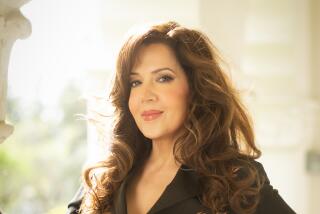A New Neighborhood for Animated Series
Behind the glass wall of a tiny sound booth, 14-year-old actress Kyla Pratt reads the lines for her leading role in a new animated series, “The Proud Family.”
On the other side of the glass sit series creator and executive producer Bruce W. Smith, co-executive producer and writer Ralph Farquhar, supervising producer Calvin Brown Jr. and story editor/series co-developer Doreen Spicer, among others. All are following along in the scripts, suggesting bits of direction, approving takes and laughing.
In many ways it is like any other voice recording session for animation, although in one way that is rare: Not only is the voice cast for “The Proud Family,” which chronicles a middle-class African American family, predominantly black, so is the key creative staff. At a time when TV has come under attack for its scarcity of minority faces and creative voices, “The Proud Family,” which premieres Friday on the Disney Channel, promises a genuine slice of what Smith calls “urban entertainment.” In other words, it’s not just a matter of digitally painting some characters a darker shade of skin tone and calling it diversity. It is a matter of depicting a specific American neighborhood and its people with some truth and fidelity.
Targeted squarely at older kids and parents, it is the first production to come from Glendale-based Jambalaya Studios, which was formed with the mandate to produce ethnic-based animation--not just African American but all ethnicities. The studio is a joint venture between Smith--who directed the 1992 feature “Bebe’s Kids” and worked as a supervising animator for such Disney features as “Tarzan” and “The Emperor’s New Groove”--and Hyperion Studio, the company behind the HBO animated series “Happily Ever After, Fairy Tales for Every Child” (produced with Smith) and Fox Kids’ “Life With Louie.”
“Tom [Wilhite, Hyperion’s president and chief executive] and I always talked about this void in the market of urban entertainment, especially in the animation side,” Smith says. “There’s this middle ground that was never really explored; it’s like animation is either totally for kids or totally for adults. And in the slate of animated films that we saw and television shows coming down the chute, animation was still not ready to diversify. This studio represents a true step in that direction and truly represents the kind of things I wanted to do. I know a lot of up-and-coming artists who speak the same language I do. The time is right.”
According to Rich Ross, executive vice president of programming and production for the Disney Channel, the time was right for the broadcaster too. “It’s incumbent upon us to see how many stories we can tell about the people who can watch us, so when it came time to adding animation for older kids and our first original [animated] series, we were really looking for something that would stand out and talk about an empowered kid in a family environment,” he says. “Luckily, Jambalaya and Hyperion stepped forward with a story that we thought had exactly the storytelling we wanted.”
In Some Ways, Series Sticks to Conventions
“The Proud Family” features many of the conventions that have governed every animated sitcom since “The Flintstones,” although with a few new, socially relevant tweaks. The show centers on teenager Penny Proud (voiced by Pratt), who lives with her breadwinning mom, Trudy (Paula Jai Parker); her harried, entrepreneurial dad, Oscar (Tommy Davidson); and her live-in grandmother, Suga Mama (Jo Marie Payton). Complications arise not only at home but at school and around the neighborhood, particularly with the Prouds’ neighbors, a Latino family named Boulevardez (the family’s teenage daughter, voiced by Alisa Reyes, is La Cienega Boulevardez).
But the creators were careful not to turn out a show that could just as easily have been done in live action. “The concept was to do an animated sitcom with things that would be impossible in live action,” Smith says. “This show is heavily action-oriented, and there are characters that can play on both sides of the fence. They can be very elastic but at the same time be very much like a sitcom actor.”
For Farquhar, a two-decade veteran of the prime-time sitcom trenches who had turned down every offer to do a cartoon series before “The Proud Family,” the size of the storytelling canvas was one of the primary attractions to jumping into animation.
“From a writing standpoint, it is so much more liberating in terms of the scope we can attempt,” he says. “Here we are doing a half-hour episode for Black History Month, this sort of ‘Black to the Future’ premise where Penny goes back in time to 1955 and experiences some of the things a young black person might have gone through in the ‘50s, [and learns] the importance of Black History Month. Her being blown, literally, by an ill wind back to 1955--we could never do that in a live-action half-hour, where you have to stay in the living room, the workplace set and maybe one other swing set.”
Interestingly, it is the kids’ TV arena--particularly on cable--that is addressing the diversity issue far more effectively than network “adult” prime time, where it is still easier to find an alien or vampire lead character than an African American, Latino or Asian. While NBC’s Saturday morning “teencoms,” such as “Saved by the Bell,” have long boasted multiethnic casts and have even explored teen interracial relationships, series such as “Happily Ever After,” the Disney Channel’s “The Famous Jett Jackson,” Nickelodeon’s “The Brothers Garcia” and now “The Proud Family” all proclaim cable’s willingness to go where most of network TV still fears to tread.
“Cable has been forced to pay close attention to the viewers, look at demographics, look at the shifting geography out there and say, ‘How can we reach a core audience that may be smaller but will ultimately yield a broader audience?”’ Ross says. But “The Proud Family” also exemplifies a classic dichotomy: Although it does matter that the show features a multiethnic minority cast, the creators are also hoping that, ultimately, it won’t matter.
“Hopefully, when people write about it, they can write a review without mentioning ethnicity; that would be refreshing,” says Farquhar, who admits disappointment that UPN’s “Moesha,” a series he co-created, was treated as “a black show.” “I was a writer for ‘Happy Days,’ and I never saw a review mention that it was a white show with a white family.”
The First Production for Jambalaya Studios
To that end, Farquhar sees “The Proud Family” placement within Disney as an asset. “The advantage of being on the Disney Channel is that, perhaps unlike if the show were on another network, they have been committed to marketing it as an animated sitcom,” he says. “They’re marketing it as a family comedy that any young person and their parents can sit down and watch, regardless of what color they are, and that’s an important difference.”
Although “The Proud Family” is the first out of the gate for Jambalaya, the company is developing more projects, including one for Showtime Online, animated through stop-motion, about a black news network that strives to swim in the mainstream and a series titled “Kung Fu Grannies,” which Smith describes as a cross between “Crouching Tiger, Hidden Dragon” and “Golden Girls.” As far as Hyperion is concerned, current and future projects are Smith’s call.
“Jambalaya was the perfect opportunity to give him a little more control than the artist usually has, with the people he already knew,” says Kurt Albrecht, Hyperion’s senior vice president of production. “I think that’s beneficial to both of us.”
And Smith is optimistic about the company’s future. “If we apply ourselves to that market that animation can’t seem to hit, either in the kids’ market or on the other side, anime , we feel like we have the formula to fill the void, that real sort of tween and teen and family audience.”
*
“The Proud Family” will premiere on the Disney Channel at 6 p.m. Friday. The network has rated it TV-G (suitable for all ages).
More to Read
The complete guide to home viewing
Get Screen Gab for everything about the TV shows and streaming movies everyone’s talking about.
You may occasionally receive promotional content from the Los Angeles Times.






